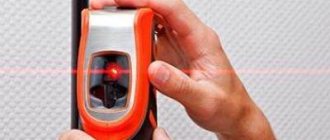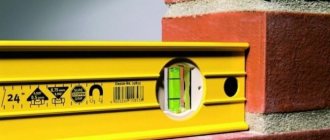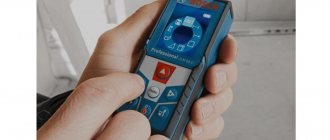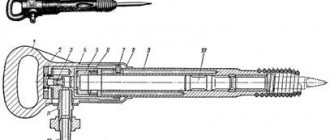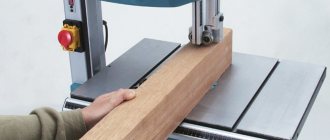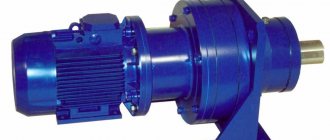For professional builders and surveyors, a level is a must-have device.
It allows you to perform measurements and calculations with high accuracy.
A huge number of types of this device allows you to choose the appropriate option for most tasks, from simple home repairs to the creation of large architectural projects.
Types of levels
The principle of operation of the device is simple - it is a telescope with a sight and a kind of spirit level, the bubble of which should ideally be in the center of the field of view. In laser levels, compared to optical levels, instead of a bubble level, there is an electronic display with values.
Height measurement is carried out by reading values from leveling rods installed in two places, including one with known parameters.
First you need to decide which level - optical or laser - you need. To operate an optical level, at least two people are required: an observer and a survey staff holder.
In the case of laser devices, the reading is not done optically, but by reading the values indicated by the light beam, otherwise nothing changes.
Table: comparison of the presented models
Making the right choice is not easy, especially with the extraordinary variety on the market. We bring to your attention a table with the most important characteristics of the levels described in the article above:
| Model | Multiplicity | Min. focal length | Availability of verification | Price |
| geobox n7-26 | 26x | 1 meter | Yes | 9-10 thousand |
| sokkia b40 | 24x | 20 cm | Yes | 15-20 thousand |
| ada basis a00117 | 20x | 30 cm | No | 7-8 thousand |
| Bosch GOL 32 D Professional | 32x | 30 cm | No | 13-15 thousand |
| Leica NA332 | 32x | 1 meter | No | 15-18 thousand |
| rgk s-20 | 20x | 20 cm | No | 8-9 thousand |
| vega l24 | 24x | 55 cm | Yes | 10 thousand |
| condtrol 32x | 32x | 60 cm | No | 12-13 thousand |
Advantages of laser levels
Laser levels work well at short measuring distances - up to 100m. With their help, you can not only measure marks, but also design heights in nature, check the curvature of vertical surfaces, measure the depth of a pit, or plan a surface at a bare level.
Cheaper optical level. For open surfaces, simple tasks and long distances it is more convenient to buy. Its range is limited only by shooting conditions and accuracy requirements.
- When choosing a laser level, do not forget to securely secure it during transportation.
- This is also important when using optical levels, but the electronics are more sensitive and require more care.
- When buying a laser level, do not skimp on versatility at the expense of quality of work; give preference to well-known and proven brands.
- Again, there is no point in overpaying for a brand; many Chinese factories offer products with excellent value for money.
Pay attention to the accuracy of the plans; excessive accuracy reduces the functionality of the device.
A good tip is to remember to buy special glasses with a laser level that allow you to see the laser beam in any room or in natural openings such as quarries or mines. They will be very useful at work.
Advantages
In the photo of the level you can see different modifications of the device, but modern models have the following advantages:
- Resistance to environmental factors.
- High level of measurement accuracy.
- Availability of a function for saving data on storage media.
- Easy to use.
- Compactness and design convenience.
- Affordable price.
Leveling accuracy
The main advantage of digital levels over optical ones is that the former, if the model has such a function, are able to automatically correct the curvature and defects of the lens.
This gives greater reading accuracy, which is not always necessary. Typically, the curvature error when measuring at distances less than 100 meters is negligible.
- Although accuracy is one of the key parameters, it is rarely displayed directly on the device.
- However, in the case of optical levels, a fairly good idea of the accuracy of the device can be obtained based on the zoom of the telescope.
- The higher the zoom level, the clearer you can see the line in the lens.
It is also worth mentioning the control of the diameter of the lens itself - a larger size improves image quality, and in the case of optical devices, the measurement accuracy depends mainly on the reading accuracy.
Device selection
The choice depends on the application. Based on this, the necessary parameters are selected. The main characteristics of the level are as follows:
- Range. For household use, 10-40 m is suitable, which is enough for interior work and construction work on the site when constructing, for example, a foundation. For professional devices, this parameter can be up to 100 m, and sometimes up to 600 m.
- Wavelength and number of rays. The number of projections can reach 5 units. This parameter affects the available options during construction and installation work. The wavelength is typically 635 nanometers. Some expensive models use a green tint beam.
- Error. The minimum value of the error gives high measurement accuracy, however, the cost of such devices will be higher.
- Temperature limit within which operation is possible. If you plan to work in the cold, then it is advisable to choose electronic models with a tolerance of -20 to +40°C.
- Dimensions and weight of the product.
- Methods of installation on site.
The use of modern models of levels in construction and repair work allows you to accurately measure distances between points and determine height differences. When choosing a device, it is advisable to choose those technical parameters that will be involved in specific types of work.
Leveler at a construction site
If you are going to use the device inside a building under construction, it is preferable to choose a laser that does not require good lighting, unlike optics. The optical level cannot work in bright sunlight. But not all laser levels allow checking at right angles, but any optical level allows this.
Some models of laser levels are equipped with a level compensator, which significantly reduces installation time.
The type of compensator is also important. A self-leveling level can use one of two currently popular compensation systems, that is, magnetic or air.
The first of these compensators provides an accuracy of 1 mm/km, and the second 2 mm/km at 32x magnification.
- A construction expansion joint does not have to be large in scope.
- For most jobs, 20x, 22x, or 24x magnification is sufficient, while a surveyor's level usually requires a device with at least 32x magnification.
- However, it is worth noting that when the staff is located at a distance of more than 30 m, higher magnification will provide more accurate readings.
RedVerg RD-GAL20 – a device for everyday use
A universal optical instrument for operations on a construction site or in the field, for geodetic work. It is used in the installation of metal industrial structures and road construction.
Image clarity and wide angle of view are ensured by the increased lens diameter. The picture is reproduced as a live image. Adjustment in horizontal and vertical planes is ensured by an automatic compensator with a magnetic damping mechanism.
Pros:
- Good picture quality.
- Ease of use and adjustment of optics to suit your own eyes.
- Unpretentious at construction sites and in the field.
Minuses:
- Poor equipment for such a price.
- Poor magnification with increased lens entrance diameter.
Magnification level
Higher magnification is not always better. At short distances, a large spot image can make it difficult to work with short targets. Therefore, when choosing a level, you should check its shortest focal length, that is, the minimum distance from which you can get a clear image of the staff.
Measuring horizontal angles is possible thanks to the so-called horizontal wheel. They are on every level, but the scale may be different. When choosing steps or a gradation scale, you should be guided only by convenience.
Leica NA332
The Leica NA332 is rightfully considered an interesting representative of levels with a shock-resistant case that protects both from weather conditions and from possible falls. A special feature of this model is two focusing speeds, which is convenient for various types of work. Precision is ensured by a highly sensitive magnetic compensator, the set of tools is absolutely standard. The cost of the tool varies between 15,000 - 18,000 rubles .
Leica NA332
Device characteristics:
| Focusing distance, min | 1m |
| Device multiplicity | 32x |
| Operating temperature, min | -20 C |
| Operating temperature, max | +40 C |
- High multiplicity
- Impact resistance
- Two speeds
- Lack of verification certificate included
- Large minimum focal length
A good thing, but more suitable for professionals (like engineers): too complicated for amateurs
Accessories
For levels you will need a modest set of accessories, only two parts. However, both are absolutely necessary:
- A tripod that provides a convenient, stable and reliable installation of the level. Aluminum tripod will be most convenient, but there are also wooden geodetic ones;
- A leveling rod, or “measuring stick,” used to read contour lines. A longer one also allows you to measure large differences in terrain, but this is not always convenient. Small ones, in turn, are convenient, but sometimes insufficient.
Most levels are not tested for water resistance at all, but for some applications a high water and dust resistance class, such as IP55, is very important.
Often the moisture protection is so poor that the lens collects condensation when the equipment is hidden in the case, and this can seriously interfere with the ability to quickly prepare the level for use.
VEGA L-24 – device with verification
Level for year-round use for all climatic zones. The design allows for operation in the most difficult field conditions. The body and elements of the device are made with a high degree of protection from external factors - dust, dirt and precipitation.
The accuracy of measurements is facilitated by the installation of a suspended compensator equipped with a magnetic damper. Supplied with registered initial verification certificate.
Pros:
- Durable, “indestructible” device.
- Not a bad price, taking into account the verification of the product.
- The presence of an optical “zoom” function at all magnifications.
Minuses:
- No tripod.
- Unreliable carrying case.
READ ALSO
15 Best Laser Rangefinders
Photos of levels (laser level)
Where can I buy?
A level is by no means an ordinary purchase. We recommend purchasing it from the manufacturers’ official stores or trusted online sites, such as:
- 220 volt;
- Sledgehammer;
- Soges.
Remember: buying used tools increases the risk of unexpected difficulties during the construction process. Safety during the construction of a particular object is paramount, so do not skimp when purchasing and do not trust unfamiliar sellers.
